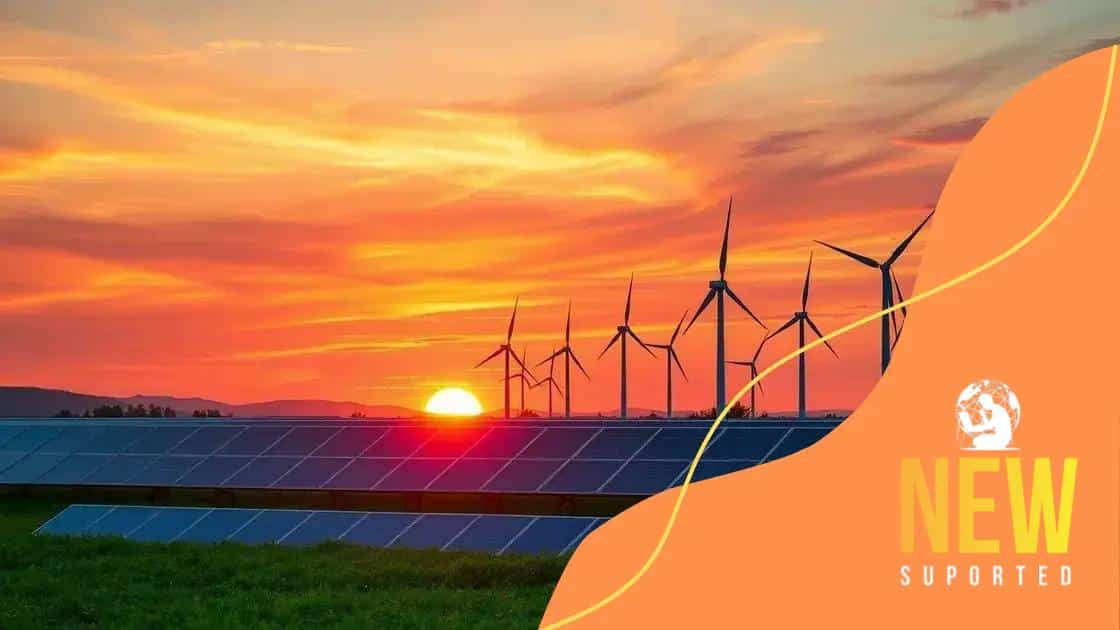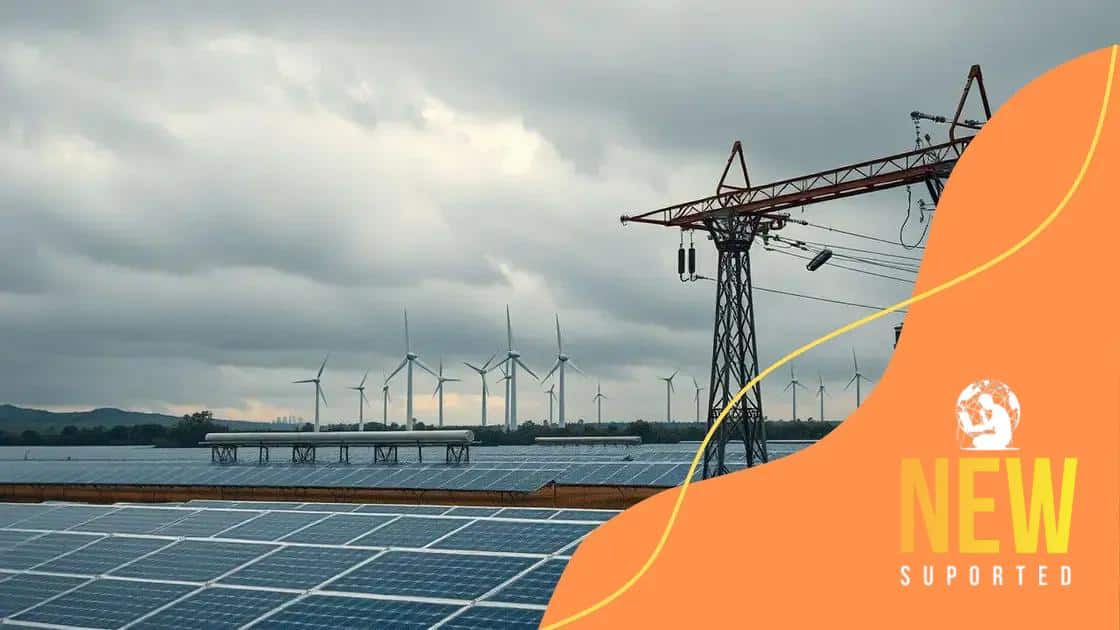The future of renewable energy technologies in the US

The future of renewable energy technologies in the US promises significant job growth, fueled by advancements in technology, supportive policies, and increased public awareness, creating diverse opportunities for skilled workers.
The future of renewable energy technologies in the US is not just a topic for discussion; it’s a glimpse into a cleaner, sustainable world. Have you ever pondered how these advancements can transform our daily lives and the environment?
Current trends in renewable energy technologies
Current trends in renewable energy technologies are reshaping how we produce and consume power. With advancements rapidly evolving, it’s important to understand what these trends mean for the future.
Emerging Technologies
One of the most exciting aspects of renewable energy is the emergence of new technologies. Innovations like floating solar panels and advanced wind turbines are gaining traction. These technologies not only maximize energy production but also minimize land use.
- Floating solar panels are installed on bodies of water, saving land space.
- Smart grid technology enhances energy efficiency and reliability.
- Advanced wind turbines offer higher output with fewer environmental impacts.
Integration of AI in Energy Systems
Integrating artificial intelligence in renewable energy systems provides significant benefits. By optimizing energy management, AI enables utilities to predict energy demand more accurately. This integration can lead to a more balanced energy supply and reduce waste.
Additionally, AI can assist in predicting equipment failures, allowing for timely maintenance and reducing downtime. This proactive approach ensures a more reliable energy supply.
Growth in Energy Storage Solutions
As we increase our reliance on renewable sources, energy storage solutions are becoming essential. Batteries, in particular, are evolving rapidly. They store energy generated during peak times for use when demand is high.
- New battery technologies are improving storage capacity and reducing costs.
- Hybrid systems that combine multiple energy sources increase reliability.
- Grid-scale storage solutions play a critical role in stabilizing power supplies.
These innovations in energy storage make renewable energy more viable, addressing availability issues and promoting sustainability.
Government and Policy Support
Government initiatives play a vital role in shaping the future of renewable energy technologies. Policies promoting sustainability stimulate investments in renewable energy. Tax incentives and subsidies encourage consumers and businesses to opt for clean energy solutions.
As governments worldwide commit to reducing carbon footprints, the push for more renewable energy resources accelerates. This movement opens doors for new jobs and economic growth in the energy sector.
With such dynamic trends, understanding the current landscape of renewable energy technologies is essential. Innovations not only drive change but also inspire confidence in a sustainable energy future. As we embrace these technologies, the path toward an environmentally friendly world becomes clearer.
Innovations shaping the future of energy
Innovations are crucial for shaping the future of energy. As the world shifts towards sustainable practices, new technologies are emerging to enhance energy efficiency and reduce dependency on fossil fuels.
Smart Grids and Energy Management
Smart grids are transforming how energy is distributed and consumed. They use digital technology to improve reliability and efficiency. This innovation allows for real-time monitoring of energy consumption.
- Consumers can track their usage through smart meters.
- Utilities can respond quickly to outages and manage peak demand.
- Integration with renewable sources maximizes energy use.
Advancements in Solar Technology
Solar energy continues to evolve, with innovations making it more accessible and efficient. New materials, such as perovskite solar cells, offer higher efficiency rates and lower production costs.
Additionally, solar panel designs are becoming more versatile. They can now be integrated into building materials, maximizing space usage in urban environments. This evolution promotes the growth of solar energy as a mainstream power source.
Wind Energy Breakthroughs
Wind energy is also seeing significant advancements. Larger and more efficient turbines are capable of capturing wind energy at lower speeds, enhancing energy generation. Vertical-axis wind turbines are gaining popularity, especially in urban areas due to their design and efficiency.
- New turbine designs reduce noise and visual impact.
- Offshore wind farms are expanding to harness stronger winds.
- Hybrid wind-solar systems maximize land use and efficiency.
These breakthroughs showcase the potential of wind energy to contribute significantly to a cleaner energy future.
Battery Storage Innovations
Energy storage is vital for balancing supply and demand, especially with intermittent renewable sources. Innovations in battery technology, like solid-state batteries, promise longer life and faster charging times.
Additionally, systems that combine various storage methods enhance resilience. These developments are crucial for enabling a reliable energy supply, supporting daily consumption and emergency needs.
As we dive into the innovations shaping the future of energy, it’s clear that these advancements are paving the way for a more sustainable approach. By embracing these new technologies, we can create a cleaner and more efficient energy landscape.
Challenges faced by renewable energy sectors

The challenges faced by renewable energy sectors are significant but not insurmountable. As the world shifts towards sustainability, understanding these obstacles is crucial for progress.
Intermittency of Energy Sources
One of the main challenges is the intermittency of renewable energy sources like solar and wind. Unlike fossil fuels, these energy sources are not always available. When the sun isn’t shining or the wind isn’t blowing, energy production can drop significantly.
- This variability can impact energy supply stability.
- Energy storage solutions are needed to bridge the gap during low production times.
- Balancing energy supply and demand becomes more complex.
Infrastructure Limitations
Existing energy infrastructure often struggles to accommodate the influx of renewable power. Upgrading power grids to handle distributed energy resources is essential. These upgrades can require significant investment and time.
Older grids may not efficiently manage the flow of electricity from various renewable sources, leading to potential losses and inefficiencies. Modernizing these grids is a top priority to support growth in the renewable energy sector.
High Initial Costs
Although the long-term costs of renewable energy are decreasing, initial setup costs can deter investment. This includes expenses related to technology, installation, and infrastructure development. Many governments offer incentives to lower these costs, but challenges still exist for businesses and homeowners.
- Financing options can be limited for small projects.
- Investors may be hesitant due to perceived risks.
- Cost-benefit analysis needs to be clearly communicated to stakeholders.
While these factors present challenges, they also highlight the need for continued innovation and policy support. Investment in research and development can lead to new solutions that make renewable energy more viable.
Regulatory and Policy Barriers
Regulatory frameworks often lag behind advancements in technology. Outdated policies can restrict the development of renewable energy projects. Navigating these regulations can pose challenges for new entrants in the market.
This inconsistency can create uncertainty for investors. Clear and supportive policies are essential to foster growth in the renewable energy sector.
Despite the challenges faced by renewable energy sectors, the drive towards sustainable energy continues. By addressing these issues through collaboration and innovation, a greener future remains within reach.
Government policies supporting renewable energy
Government policies play a crucial role in supporting the renewable energy sector. By implementing favorable policies, governments can encourage the development and use of clean energy sources.
Incentives and Tax Breaks
Many governments offer incentives to reduce the costs associated with renewable energy projects. Tax breaks and grants can make it easier for businesses and homeowners to invest in technologies like solar panels and wind turbines.
- Tax credits reduce the upfront cost of purchasing renewable systems.
- Grants can fund research and development for new technologies.
- Incentives help create jobs in the renewable energy sector.
Renewable Portfolio Standards
Renewable Portfolio Standards (RPS) require utilities to obtain a certain percentage of their energy from renewable sources. These mandates create a reliable demand for renewable energy and encourage investments.
By establishing clear targets, RPS helps drive the growth of the renewable sector. States are often the ones implementing these standards, leading to varying requirements across the country.
Government Funding for Research
Public funding supports research and development in renewable technologies. Government grants can help universities and research institutions innovate and improve existing technologies.
- Funding can foster advancements in energy storage solutions.
- Research may lead to more efficient solar panels and turbines.
- Innovations can drive down costs and improve performance.
This investment in research provides a solid foundation for growth in the renewable energy industry. Without it, technological advancements might stagnate, hindering progress.
International Agreements and Cooperation
International agreements, like the Paris Agreement, also influence national policies on renewable energy. These agreements push countries to commit to reducing greenhouse gas emissions, often leading to stronger domestic policies.
Cooperation between countries can aid in sharing technology and best practices. By collaborating, nations can enhance their renewable energy goals and share resources effectively.
Ultimately, supportive government policies are key to advancing the renewable energy sector. By establishing strong frameworks and incentives, governments set the stage for a sustainable energy future.
Future job opportunities in renewable energy
The future job opportunities in renewable energy are promising as the world shifts towards sustainability. With significant investments in this sector, new roles are being created across various fields.
Growing Demand for Skilled Workers
As the renewable energy industry expands, the demand for skilled workers continues to rise. These jobs can range from engineering to installation and maintenance of renewable energy systems.
- Engineers design innovative renewable energy technologies.
- Technicians focus on installing and maintaining solar panels.
- Project managers oversee renewable energy projects, ensuring they meet deadlines and budgets.
Renewable Energy Training Programs
The growth in job opportunities has led to an increase in renewable energy training programs. Many educational institutions now offer courses tailored to the needs of this evolving industry.
These programs not only teach essential skills but also provide hands-on experience. Students gain valuable insights into the latest technologies and practices in renewable energy.
Advancements in Technology Creating New Roles
As technology advances, new job roles are emerging. Innovations in energy storage, smart grids, and sustainable materials are creating additional opportunities in the field.
- Data analysts work on optimizing energy consumption patterns.
- Research scientists focus on developing new renewable energy technologies.
- Sales and marketing positions are increasing as demand for renewable solutions grows.
These advancements highlight the need for a workforce that understands not only renewable energy systems but also the technologies that support them.
Policy and Management Careers
With the shift toward renewable energy, there is also a growing need for professionals in policy and management. These roles are crucial for developing strategies that promote clean energy adoption.
Policymakers work to create regulations that support renewable investments, while managers help organizations transition to sustainable practices. These positions require a mix of technical knowledge and an understanding of environmental issues.
The future job opportunities in renewable energy present an exciting path for many individuals. As the sector grows, it offers varied career options that contribute to a more sustainable planet.
The renewable energy sector is growing rapidly and offers many opportunities for the future. This growth is fueled by technological advancements, supportive government policies, and increasing public awareness of the importance of sustainability. As we move forward, the demand for skilled workers will rise, creating a diverse range of job opportunities. By investing in education and training, we can prepare the workforce for these roles, ensuring a smoother transition to renewable energy solutions and a cleaner planet for future generations.
FAQ – Frequently Asked Questions about Renewable Energy Job Opportunities
What types of jobs are available in the renewable energy sector?
There are many roles, including engineers, technicians, project managers, and data analysts, all contributing to the growth of renewable energy.
How can I prepare for a career in renewable energy?
Consider enrolling in training programs or courses that focus on renewable technologies and sustainable practices.
Are there government incentives for jobs in renewable energy?
Yes, many governments offer incentives and grants to support education and training in renewable energy fields.
What is the future outlook for jobs in renewable energy?
The demand for skilled workers is expected to rise as the industry continues to grow, providing numerous job opportunities.






